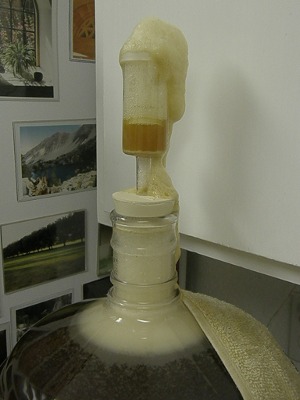Start Rolling Bottling, Labeling Tasting
October 7, 2009
After thirty years since my last adventure in zymurgy I'm in the midst of brewing a batch of beer. Dad left some beer-making equipment and a kit for brewing a batch of "Irish Strong Red Ale"; these had been languishing in a corner of the garage for some time. Recently I got the urge to have another go at making an ale and did an inventory of the equipment to see what else would be needed.
There was a primary fermenting vessel, thermometer, sacharometer, a pressure keg, the ale ingredients, and various cleaning/sterilizing compounds. It turned out the pressure keg was missing a gasket, and even if the keg were complete I would have had to have a small refrigerator and stash the thing inside of it, so I elected to go the bottling route. This meant I needed bottles and caps and a capper.
The bottles weren't a problem; Vince works at the Saddle Club and was able to collect enough champagne bottles there to deal with a 5 gallon batch of brew (26 bottles to be safe). He rinsed out the bottles and put them aside in a couple of boxes that the champagne originally came in. Turns out that only American champagne bottles can be capped; European champagne (well, French really) bottles have a bottle shape incompatible with standard cappers found in this country. The rest of the gear I found at a place called The Beverage People - a 7.5 gallon steel stock pot, capper, caps, siphon equipment, bottle filler, secondary fermentor (basically a plastic water-cooler-sized bottle) and valve.
I also needed some yeast; the original yeast for the beer kit had been in our refrigerator for ages and we had given it the toss during a refrigerator clean-and-purge cycle. This turned out to be a good thing because live brewing yeast does have a shelf-life. For some reason when I ordered it I blanked on the type of ale kit it was for, and I asked for Scottish ale yeast. Later I realized that the recipe was for an Irish Red Ale (later, as in after I had introduced the yeast into the brew) and the result might be interesting - a Scotch-Irish concoction.
 With all the ingredients and equipment in hand the very next day I boiled up the
brew, steeped the grain, rinsed the result into the wort (the as-not-yet-fermented brew),
cooled the wort down and poured it into the 6 gallon plastic bucket that made up the
primary fermentation vessel. The last step was to pour in the yeast and hoist the
rather full primary fermentor up onto the kitchen counter, and as I was hugging the
container for dear life some of the sweet wort slopped onto me. This was the first
inkling that the wort was alive and determined to escape.
With all the ingredients and equipment in hand the very next day I boiled up the
brew, steeped the grain, rinsed the result into the wort (the as-not-yet-fermented brew),
cooled the wort down and poured it into the 6 gallon plastic bucket that made up the
primary fermentation vessel. The last step was to pour in the yeast and hoist the
rather full primary fermentor up onto the kitchen counter, and as I was hugging the
container for dear life some of the sweet wort slopped onto me. This was the first
inkling that the wort was alive and determined to escape.
Initially there wasn't much action and I was concerned that the wort wasn't warm enough, but not to worry; after a day it began to foam and in two days it foamed enough that it pressed up against the lid on top and actually pushed it an inch from the top of the container - the second inkling that the wort was bent on escape.
After a few days the foam subsided and I began to be concerned that perhaps the yeast had died off, so quick like a bunny I pulled out the secondary fermentation container, the 5 gallon water bottle, siphoned the liquid from the primary fermentor into it, hoisted it onto the kitchen counter, put on a clear plastic valve primed with water, and wondered if the wort had died. I had to go to work so I left the wort to its own devices; when I came back home the yeast was foaming so briskly that it had foamed its way through the valve and was building a foam cap on top of it (see picture). The wort was on the run again. When I discussed this with home brewers at work they said that the primary fermentation takes about a week; I had rushed it by three days. Ideally the secondary fermentation is a slow, stately business, not a case of wort gone wild.
It's been a couple of days now since that happened; the wort is still fizzing away but the massive foaming is in decline. I rinsed the valve three or four times, and now it is staying clean. It will be another week in the secondary fermentor, maybe a bit longer, until it can be bottled. Stay tuned . . .

